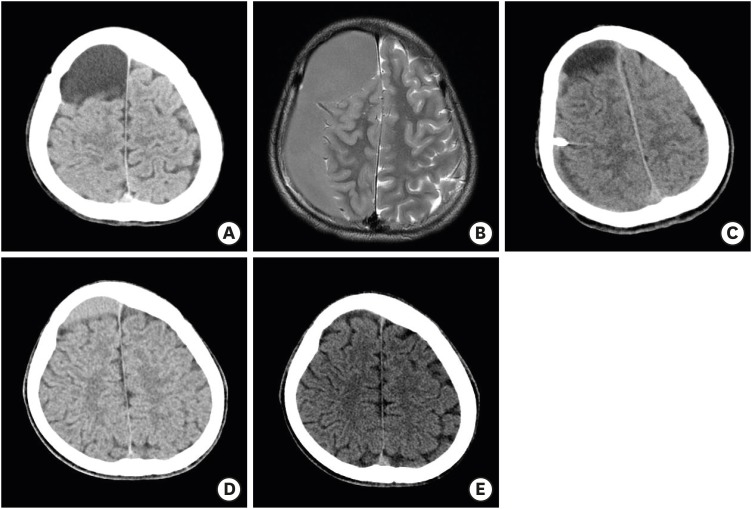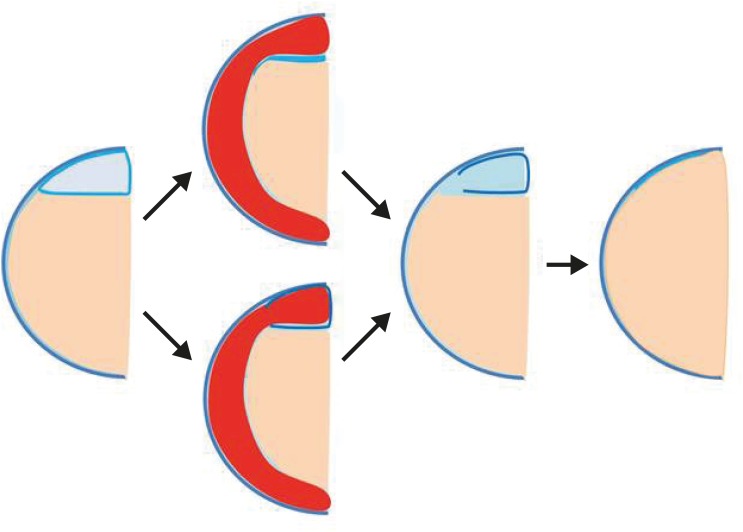1. Al-Holou WN, Yew AY, Boomsaad ZE, Garton HJ, Muraszko KM, Maher CO. Prevalence and natural history of arachnoid cysts in children. J Neurosurg Pediatr. 2010; 5:578–585. PMID:
20515330.

2. Domenicucci M, Russo N, Giugni E, Pierallini A. Relationship between supratentorial arachnoid cyst and chronic subdural hematoma: neuroradiological evidence and surgical treatment. J Neurosurg. 2009; 110:1250–1255. PMID:
18976058.

3. Hall A, White MA, Myles L. Spontaneous subdural haemorrhage from an arachnoid cyst: a case report and literature review. Br J Neurosurg. 2017; 31:607–610. PMID:
27279460.

4. Kwak YS, Hwang SK, Park SH, Park JY. Chronic subdural hematoma associated with the middle fossa arachnoid cyst: pathogenesis and review of its management. Childs Nerv Syst. 2013; 29:77–82. PMID:
22914923.

5. Mori K, Yamamoto T, Horinaka N, Maeda M. Arachnoid cyst is a risk factor for chronic subdural hematoma in juveniles: twelve cases of chronic subdural hematoma associated with arachnoid cyst. J Neurotrauma. 2002; 19:1017–1027. PMID:
12482115.

6. Mori T, Fujimoto M, Sakae K, Sakakibara T, Shin H, Yamaki T, et al. Disappearance of arachnoid cysts after head injury. Neurosurgery. 1995; 36:938–941. PMID:
7791985.

7. Nadi M, Nikolic A, Sabban D, Ahmad T. Resolution of middle fossa arachnoid cyst after minor head trauma - stages of resolution on MRI: case report and literature review. Pediatr Neurosurg. 2017; 52:346–350. PMID:
28848171.

8. Page A, Paxton RM, Mohan D. A reappraisal of the relationship between arachnoid cysts of the middle fossa and chronic subdural haematoma. J Neurol Neurosurg Psychiatry. 1987; 50:1001–1007. PMID:
3655804.

9. Park HR, Lee KS, Bae HG. Chronic subdural hematoma after eccentric exercise using a vibrating belt machine. J Korean Neurosurg Soc. 2013; 54:265–267. PMID:
24278662.

10. Parsch CS, Krauss J, Hofmann E, Meixensberger J, Roosen K. Arachnoid cysts associated with subdural hematomas and hygromas: analysis of 16 cases, long-term follow-up, and review of the literature. Neurosurgery. 1997; 40:483–490. PMID:
9055286.

11. Pirayesh Islamian A, Polemikos M, Krauss JK. Chronic subdural haematoma secondary to headbanging. Lancet. 2014; 384:102. PMID:
24998813.

12. Seizeur R, Forlodou P, Coustans M, Dam-Hieu P. Spontaneous resolution of arachnoid cysts: review and features of an unusual case. Acta Neurochir (Wien). 2007; 149:75–78. PMID:
17180304.

13. Takayasu T, Harada K, Nishimura S, Onda J, Nishi T, Takagaki H. Chronic subdural hematoma associated with arachnoid cyst. Two case histories with pathological observations. Neurol Med Chir (Tokyo). 2012; 52:113–117. PMID:
22362297.
14. Takizawa H, Sugiura K, Kudo C, Kadoyama S. Spontaneous disappearance of a middle fossa arachnoid cyst--a case report. No To Shinkei. 1991; 43:987–989. PMID:
1799503.
15. Takizawa K, Sorimachi T, Honda Y, Ishizaka H, Baba T, Osada T, et al. Chronic subdural hematomas associated with arachnoid cysts: significance in young patients with chronic subdural hematomas. Neurol Med Chir (Tokyo). 2015; 55:727–734. PMID:
26345665.

16. Wester K, Helland CA. How often do chronic extra-cerebral haematomas occur in patients with intracranial arachnoid cysts? J Neurol Neurosurg Psychiatry. 2008; 79:72–75. PMID:
17488784.

17. Wu X, Li G, Zhao J, Zhu X, Zhang Y, Hou K. Arachnoid cyst-associated chronic subdural hematoma: Report of 14 cases and a systematic literature review. World Neurosurg. 2018; 109:e118–e130. PMID:
28962953.

18. Yamanouchi Y, Someda K, Oka N. Spontaneous disappearance of middle fossa arachnoid cyst after head injury. Childs Nerv Syst. 1986; 2:40–43. PMID:
3731162.







 PDF
PDF ePub
ePub Citation
Citation Print
Print



 XML Download
XML Download